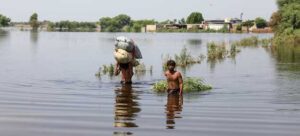
Biodiversity, Caribbean Climate Wire, Civil Society, Climate Action, Climate Change, Conferences, Development & Aid, Economy & Trade, Editors’ Choice, Environment, Global, Green Economy, Headlines, Ocean Health, PACIFIC COMMUNITY, Pacific Community Climate Wire, Small Island Developing States, Sustainable Development Goals, TerraViva United Nations

Li Junhua, head of the UN Department of Economic and Social Affairs (DESA) and the Secretary-General, Jérôme Bonnafont, Permanent Representative of France to the UN and Costa Rican Ambassador Maritza Chan Valverde during a press conference ahead of the UN Ocean Conference in Nice: Credit: Twitter
– A greater understanding and appreciation of the world’s oceans is needed to protect them. As the global community prepares to convene for the ocean conference, they must also prepare to invest in scientific efforts and education that will bolster their joint efforts.
France and Costa Rica will co-host the 3rd United Nations Ocean Conference (UNOC3) in Nice, France, from June 9-13. Over the course of the week, governments, the private sector, intergovernmental groups, and non-governmental groups, among others, will convene over the urgent actions that need to be taken to promote the conservation and sustainable use of the oceans.
This year’s conference will be the first to take place during the UN Decade of Ocean Science for Sustainable Development (2021-2030), which brings together stakeholders in which the UN and its partners will oversee the actions that need to be taken to protect the oceans’ unique ecosystems and biodiversity and how to promote greater awareness and research into ocean sciences and how to better protect them.
UNESCO’s Intergovernmental Oceanographic Commission (IOC) oversees and tracks the progress of the UN Ocean Decade, which brings together the global ocean community on the principles of understanding, educating, and protecting the oceans.
There will be an emphasis on strengthening the data-collection capacities in the global system for observing the ocean. Data scarcity and limitations in collection methods have meant that organizations have challenges grasping the full scope of the ocean and the changes they face in the wake of climate change.
Julian Barbiere, UNESCO’s Head of Marine Policy, told reporters that science-based discussions will be at the core of UNOC. For UNESCO, there will be discussions over how to translate scientific facts into tangible climate actions. This includes scaling up the current efforts at ocean-floor mapping. At present, only 26.1 percent of the seafloor has been mapped out by modern standards, with the goal to have 100 percent of the seafloor mapped out by 2030.

Seaweed is grown or farmed in the shallow waters of the Indian Ocean, off Wasini Island, Kenya, with plants tied to ropes in the water. Credit: Anthony Onyango / Climate Visuals
Joanna Post, head of the IOC’s Ocean Observations and Services, remarked that there is a “real need for recognition” of the critical functions that the system performs, such as in monitoring weather conditions, mapping the ocean floor, maritime security, and disaster risk management. She announced a new initiative that would mobilize at least 10,000 commercial and research ships to collect data and measure the ocean. Commercial and research ship vessels play a key role in tracking and collecting data on the oceans, which Post emphasized must be shared across global channels.
UNESCO’s agenda for this forum also includes encouraging stakeholders to invest in and strengthen global education efforts on the ocean. “Education is key if we want to have a new generation that is aware of the importance of the ocean system,” said Francesca Santoro, a senior programme officer in UNESCO, leading the Ocean Literacy office.
Santoro stressed that education is not limited to students and young people; private investors should also be more aware of the importance of investing in the oceans.
UNESCO aims to continue expanding the networks of schools and educators that incorporate ocean literacy into their curricula, especially at the national level. Ocean literacy emphasizes the importance of the ocean for students, educators, and local communities within multiple contexts.
One such programme is the SEA BEYOND initiative, in partnership with the Prada Group, which provides training and lessons to over 20,000 students in over 50 countries. Under that initiative, a new multi-partner trust fund will be launched at UNOC3 on June 9, which will be used to support projects and programs that work toward ocean education and preserving ocean culture. As Santoro noted, “For many people and local communities, the main entry point to start interest in the oceans… is in [identifying] what UNESCO calls ‘intangible cultural heritage.’”
Human activity, including pollution, “directly threatens” the health of the ocean, according to Henrik Enevoldsen from UNESCO-IOC’s Centre of Ocean Science.
He announced the development of a new global assessment, led by UNESCO and the UN Environment Programme (UNEP), on marine pollution, to be launched on June 12. This would be a “major leap forward,” Enevoldsen remarked, adding that this assessment would be the first of its kind that provided a global overview of ocean pollution.
IPS UN Bureau Report





